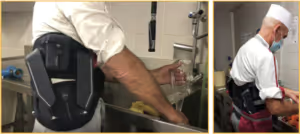
The company Elior provides collective catering services for its customers, which may be businesses, schools or medico-social institutions. The company has the main customer to satisfy, but also the guests through the meals distributed.
What were the problems before setting up the exoskeleton?
When I arrived at Elior, I realized that there were different types of constraints, with repetitive gestures but also employees tested by years of work. Prevention and safety at work have evolved a lot in 20 years, as has the consideration of risks.
We have several constraints: we are an external company for a user company therefore we do not control the layout of the premises, the surfaces, the hardware made available by the customer, which leads to space, structure and sometimes floor constraints, which do not necessarily allow us to introduce a trolley even at a constant level. Overall, we are very dependent on structures that we cannot influence.
Second, we can produce up to 5000 meals at one location to deliver to other establishments. To ensure our services, we have load port constraints since you have to transport meals to deliver them in a short time.
“Our services introduce load ports, repetitive actions and additional constraints that can lead to workplace accidents.”
What was your approach before adopting our Japet.W exoskeleton?
Faced with these problems, I asked myself how we could organize a position taking into account the constraints we have.
I told myself that I had to find a process that was compartmentalized, progressive and homothetic for all of France. That's why I established a complete approach Who goes from the detection of the need Until testing passing through the device selection.
Once the device is installed, a logbook is given to the employee, which allows him to be monitored for a period of 2 years. Depending on the system, we will have more or fewer appointments. Some devices will require more intensive monitoring and others that will be a bit lighter. The approach also had to be multidisciplinary, by integrating Occupational doctors, coordinators, job retention services and Health and Life at Work services (SSVT).
“The device is only part of the station layout. If you don't do the rest, setting up the device can't work.”
We are in the complete process until the modification of the single document with the integration of the exoskeleton.
How did you integrate the Japet.W exoskeleton?
Following our occupational health and safety approach, we opted for the Japet.W exoskeleton, which met the needs of our cook suffering from low back pain.
It allows you to accompany him in his cooking gestures : decontaminate vegetables, peel them, cut them and put them in a standing and static position that strongly stresses the back.

For complete the layout of the station, we set up a sink riser, a cart and a variable-height preparation table to avoid leaning your back and having lumbar strain.
Since integrating the exoskeleton, have you noticed any changes?
We were able to observe positive changes on teams. It is important to take the time necessary to support the employee because beyond the layout of the position and the occupational safety rules to be respected, it is also about showing respect, listening and exchanging with him, a return to human values simply.
“Take the time to give trust and respect to the value of the collaborator as an individual, who is in perfect control of his position.”
When I talk about value, it's a human value, a Know-how value. If we remove this piece from the team puzzle, there will be a big lack of cohesion. I want them to tell themselves that they are not just numbers.
It is important for our employees to know that we care about them too, and that safety is not just constraints, it can be beautiful things. There is a positive snowball effect within the team, with a physical and social effect, through a CSR rebound.
For our cook, Thierry, staying up for 2 hours to serve at the snack was extremely painful. He was happy to say to himself “Even if I don't go back to the cafeteria every day, I will be able to go back and talk to the guests again”, this gives another dimension and value to his work. When food is produced, it is produced to make a guest happy.
What do you like the most about the exoskeleton solution?
It is pioneering, you have to live with the times too. When it comes to safety at work, you have to know how to question yourself in order to move towards a new technology and see how you can manage it to integrate it.
For my part, it was not to do CSR, I was very surprised at the extent of the approach, because at the beginning, I did this approach in a humble way, for the employee. Resolutely, it is a human approach above all else.
“The idea is to use this innovative technology that is evolving rapidly to serve an employee and maintain skills, which is what attracted me to this.”
For what task (s) and what position (s) would you recommend the exoskeleton?
Delivery driver, storekeeper, and for people who have lumbar pathologies, on production.
If you had to summarize your Japet experience?
For my part, it is a trusted experience And of human contact. We often have the image of a startup as innovative young people full of energy who are making rapid progress, it's true, but there I also found the family spirit.
I was also able to meet Jean-François CRAIPEAU, farrier and user of the Japet.W exoskeleton, who gave me another dimension on pain management.
“When you prepare a meal, you have an appetizer that you put in a window. You do it with love, because it's your job, but you have to be free from constraints to do it that way.”
Any last words?
People only remember something innovative, robotic, and productivity-boosting about an exoskeleton, but that's not it. We are not going to make supermen.
“Stay collaborator-centered.”




